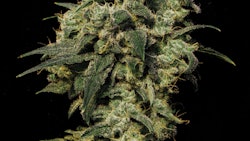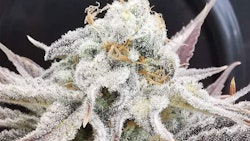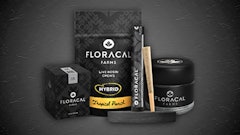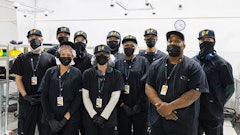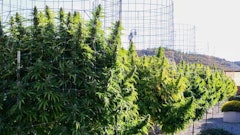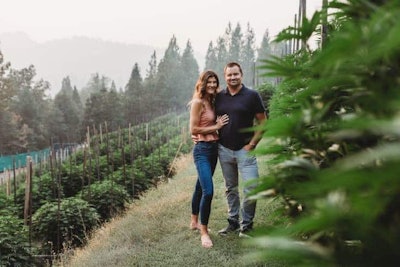
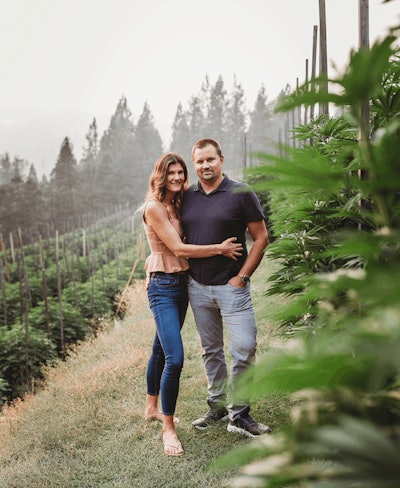
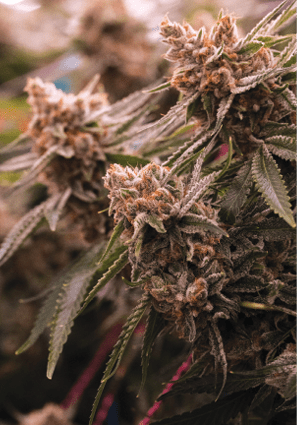
Oregon is home to a historically rich and diverse agricultural industry, with commodities ranging from pears and timber to grapes and hops. In recent years, however, a commercial crop has entered the fray for farmers in The Beaver State: cannabis.
Oregon was one of the first states to legalize adult-use cannabis in 2014 and, while seven years may seem like a relatively short amount of time for an industry to develop, a mature cannabis marketplace has emerged, filled with both newbies and legacy medical growers who preceded adult-use legalization.
Among those legacy growers is Grown Rogue, an indoor and outdoor cultivator located in the Rogue Valley of Southern Oregon.
Husband-and-wife team Obie and Sarah Strickler got their start in Oregon’s medical program in 2006, but moved to adult-use in 2016 and founded Grown Rogue. After establishing its Northwestern roots, Grown Rogue expanded eastward to Michigan, acquiring a controlling interest in cultivation company Golden Harvests in 2020.
With more than 200,000 sq. ft. of both indoor and outdoor cultivation space across Oregon and Michigan, Grown Rogue has certainly grown over the past 15 years. However, the company’s journey to becoming a multistate operator in an everchanging industry wasn’t always a smooth ride.
Getting Growing
Grown Rogue’s foundation and company mission centered on alternative health and providing safe, high-quality medicine to the market. However, when Obie began designing Grown Rogue’s first indoor facility in 2016, there were few, if any, industry resources for him to rely on.
“Everyone was just holding everything so close to the vest,” Obie says. “There was a real lack of transparency and collaboration.
“People will protect proprietary [information], like technology and software … [But] your ability to control your cannabis product, I don’t think it has that same level of requirements. You don’t see [secrecy] in any other ag business, so I think it’s a little bit of naivety, and I think you saw people wanting to make cannabis something it wasn’t.”
The company also recognized the importance of connecting long-time growers with industry newbies.
“The key to this business and this industry is bridging the hippies and the suits,” Obie says. “You’ve got this legacy platform of people selling cannabis across borders and internationally. When you regulate it, a lot of companies went public and legal and needed some business sophistication. Creating that culture that works together is one of the things we identified early, and we work on it every single day.”
One way Grown Rogue bridged the divide was by hiring a horticulture industry veteran to help lead their company—Tom Fortner, who founded Willow Creek Greenhouses before the company was purchased by Hines Horticulture in 1999. As legacy growers themselves, Obie and Sarah boosted Grown Rogue’s business sophistication by appointing Fortner as COO to help Grown Rogue scale the business as it continues its expansion as a multistate operator.
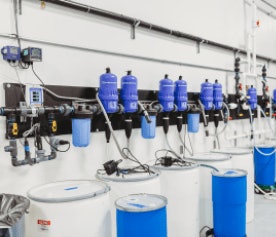
MSO Complexities
While Grown Rogue has both outdoor and indoor cultivation in Oregon, compared to just indoor in Michigan, Obie estimates that 80% of Grown Rogue’s Oregon operations were transferable to the Michigan market—including growing, trimming, material handling, and ordering methods know-how.
“Just a small portion of that was site-specific to Michigan,” Obie says. “Testing [in Michigan] is just a little more regimented.”
Another difference between the two states is how canopy space is measured: In Oregon, your canopy space is limited by square footage, whereas in Michigan you have limits on the number of plants you can grow.
While cultivation and compliance practices transferred well, the company ran into other hurdles.
“The issue isn’t in the variance in terms of what we had to do differently [in Michigan], it’s just about how do you transfer that knowledge? COVID didn’t help with that. One of the biggest challenges was we just couldn’t get our people there as frequently as we would like, so we really had to learn through Zoom and discussion,” Obie says. “We’ve had several of our team [members] out there, I go there every month to six weeks, our COO [Tom Fortner] is out there about the same kind of frequency. We’ve sent some of their people to Oregon to sit in our facility and learn and train. That’s been really helpful.”
Grown Rogue’s Oregon operation comprises 80,000 sq. ft. of outdoor space and 47,000 sq. ft. of indoor space. The outdoor cultivation is entirely flowering canopy, while the indoor space has 20,000 sq. ft of flowering canopy. The remaining 27,000 sq. ft. of indoor space supports processes ranging from propagation and veg space, packaging, trimming, and other ancillary support for flower production.
Grown Rogue initially cultivated outdoors under Oregon’s medical market, but began building its indoor facility while licensing its outdoor farm for adult-use legalization. In total, Grown Rogue holds four tier II cultivation licenses, two wholesale licenses, two processing licenses, and one retail license.
While Obie and Sarah say they prefer outdoor cultivation—where their roots began—because of the lower costs and future export opportunity, the addition of the indoor facility provided stability for the business.
“We always knew that outdoors is where we wanted to be, but indoor is a much more steady state,” Obie says. “It’s a consistent monthly production revenue stream. It’s much easier to run your business with [indoor] because outdoor has such seasonality spikes, so it’s less stable.”
In Michigan, meanwhile, Grown Rogue’s indoor grow facility comprises 80,000 sq. ft., about half of which should be fully operational by the end of this year. The Michigan facility is owned by Canopy Management, of which Obie and Sarah own 92.5% and say was formed solely for licensing purposes.
No matter the state, Grown Rogue aims for an indoor production cost of $0.80 per gram.
“I’d like to say it was because we’re just so efficient and amazing and thoughtful, but the reality is Oregon required us to get ultra-efficient,” Obie says. “We didn’t have a choice. We went through massive price compression, and through necessity, we created a very efficient operating structure through just a great team.
“With some of the training costs and bringing on new staff, that’s fluctuated a little bit outside of that 80-cent range, but we’ve achieved that in the past and that’s where we set targets from a cash perspective.”
When it comes to outdoor cultivation in Oregon, Grown Rogue aims for about half the cost of indoor flower production.
“I’d like to be below 40 cents,” Obie says. “And we’re [close to] there, probably [at] 50 cents.”
Obie says those financial goals factor in a number of costs associated with flower production—including labor, irrigation, testing, nutrition, pest management, and power.
“It’s part of the culture that we’ve built, spending our capital like it’s your own,” Obie says. “Now, within reason though. You can push too hard sometimes on costs and it actually has a negative effect, but we’ve done a really good job of balancing conscientious cost spend with the needs of the organization to actually deliver results.”
The goal for Grown Rogue is to replicate its efficiency in Oregon in the Michigan market, which Obie says is “catching up quickly.” While Obie admits there are some cost differentials between the two states, such as more expensive licensing and electricity in Michigan, he’s adamant those contrasts won’t make a material difference in terms of operational efficiency.
“We’re not quite there yet,” he says in regards to Grown Rogue’s Michigan operations matching Oregon’s efficiency. “From a pure operational standpoint, we’re getting pretty close.”
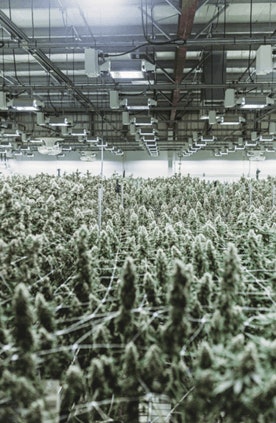
One issue Grown Rogue faces in Oregon, specifically, is canopy restrictions. Obie says that these limits force the company to grow bigger plants to maximize space, thus adding to operational costs.
“We like the canopy restrictions long-term when [federal legalization] occurs to limit big money coming in and taking a big position in Oregon,” Obie says. “But it does impact our efficiency slightly because we have to adjust our method to account for regulatory restrictions.”
Despite the obvious challenges of complying with different rules in different markets, Obie says there are a number of benefits to being a multistate operator.
“[Being an MSO] takes away some of the market risk,” he says. “Being leveraged in just one state, you’re really dependent upon the market conditions in that state. It gives you a little bit of diversity [and] more brand exposure, which is really important. Being a multistate [operator] gives you a bigger footprint, and you can build a bigger business [when] you’ve got more market you can surf.”
Focused on Flower
Grown Rogue formerly had products ranging from concentrates to cartridges to edibles, but narrowed its focus to flower cultivation, specifically. Obie says that while the company often considers expanding its product portfolio, they can’t justify the economics.
“We still haven’t maximized our market share in flower, so none of the other products that we can put numbers around actually make more sense than just flower production,” Obie says. “Why should we turn our trim into a vape cartridge or something? We’re better off just selling it to the processors to do that.
“That being said, once we get a little bit more stability and market share in flower, we’ll look to expand, mostly from a brand perspective, from a position of power and support and size as it relates to the flower market,” he adds.
While Grown Rogue doesn’t offer an array of products, it does offer a variety of cultivars, including Rogue OG, Mothers Milk, GMO Cookies, and more. Grown Rogue emphasizes genetic diversity to create a number of options for consumers, and Obie estimates the company currently has about 30 flower genetics in its portfolio, and could have as many as 50 by the end of this year.
Grown Rogue purchases genetics rather than breed them, and uses four equally important criteria when selecting genetics: yield, potency, bag appeal and flavor/aroma.
“The problem is [with] almost every genetic, if you’re lucky, you get three of those four,” Obie says. “For the most part, maybe you get two of them. When you find all four, it’s one you keep and hold on to very carefully.”
“Each market wants a variety of strains. They want that diversification of products,” Sarah says of Oregon and Michigan. “Although, what we’re seeing in Michigan is they really liked the fruity flavors—our Strawberries and Cream and Gelato Punch. So they’re definitely more trending towards a fruitier vibe out there, whereas the Oregon market just wants continuous change and diversification of the product line.”
Another notable difference between Grown Rogue’s Oregon and Michigan operations is the company’s patented, nitrogen-sealed flower jars that were launched in December 2020 and are available only in Michigan.
The jar lids are screen-printed, the labels hand-applied, and each bud that goes into the jars is hand-selected. The jars are then vacuum-sealed and nitrogen-injected to keep the flower fresh while maximizing potency and terpenes.
“How do you maintain quality of cannabis? There’s three criteria: light, oxidation, and heat,” Obie says. “This [jar] definitely fixes the oxidation component. So as long as you store it in a cool temperature and don’t expose them to a lot of light, you’re not going to get any oxidation.
“We tried to launch them in Oregon [in 2018], but Oregon is not a pre-packaged state,” Obie says of Oregon’s regulations requiring flower to be served “deli-style” and packaged at the point-of-sale. “So it took us about three years to bring this concept to market, and Michigan, with a moderately sized pre-packaged flower business, seemed like the perfect opportunity to launch.”
While Grown Rogue’s nitrogen-sealed flower jars are still new to the Michigan market, consumers’ response to the product has exceeded even Grown Rogue’s expectations.
“Our nitrogen-sealed jars are flying off the shelves,” Sarah says. “That’s been really exciting to see that in Michigan and be so well-received.”
According to MarketScape data from LeafLink, pre-packaged flower holds about a 20% share of Michigan’s flower market and sells for higher prices than bulk flower. Grown Rogue’s nitrogen-sealed jars account for about 30% to 40% of its monthly sales, according to the company, and sell at a price about 25% higher than the state pre-packaged average sales price, a sign that consumers are paying a premium for Grown Rogue’s product.
With the nitrogen-sealed jars gaining traction in Michigan, Grown Rogue will now turn its attention to lowering production costs. Obie says the all-in cost of the jars—the jar itself, the label, sealing, lid printing, product loading, labor, etc.—hovers around $2, excluding the flower product inside.
“[With] the labeling process, we’re looking at different ways to remove the labor component of that, so either getting them shrink-wrapped or get a labeling machine [to] automate the system,” Obie says. “And the next thing is auto-fill, so you can get machines that will actually fill the container with your product.”
Obie says the goal is to get the production costs of the jars down to around 50 cents per container (not including the flower product).
“I don’t know if we’ll get there, but that’s what we’re targeting,” he says. “Instead of buying 10,000 jars at a time, if you buy 250,000, you’re going to get economies of scales [when you] automate the process.”
Capital Decisions
One hurdle to clear before these efficiencies and automation tools can be implemented is finding the investment capital—an often-difficult task for cannabis businesses. However, Grown Rogue is better positioned than most to tackle this problem, as it has been publicly traded on the Canadian Securities Exchange (CSE) and Over the Counter (OTC) markets since 2018.
“[Going public] allowed us to access capital and provided liquidity for our shareholders,” Obie says. “At the same time, it creates more complexity as you now have another business—the capital markets—[that has] lots of reporting requirements and also [requires] effort and focus on investor relations and managing your stock.”
Grown Rogue’s ability to access funding through capital markets has allowed the company to strategically expand as it continues to grow. Obie says Grown Rogue would “absolutely like to move to the main [capital] markets once the U.S. allows for that,” but in the meantime will maintain its disciplined focus on acquiring distressed cultivation assets to maximize ROI for company shareholders.
One recent example of Grown Rogue’s strategic expansion came this past February when the company acquired a 30,000 sq. ft. indoor facility in Oregon and a Portland retail dispensary from Acreage Holdings.
“This acquisition is right in our wheelhouse and in our backyard,” Obie says. “We got a great deal on the asset [and] the grow is five minutes from our existing indoor facility.”
Another strategy Grown Rogue ostensibly favors is to slowly take over companies over a period of time rather than to suddenly buy another company out, an example playing out now in its Michigan cultivation facility. Grown Rogue’s Michigan partner, Canopy Management, exercised a 60% controlling interest in Golden Harvests this past June and, at the same time, Grown Rogue has an option to acquire 87% of Canopy’s membership units—a move the company says is expected by the end of this year.
“The Michigan asset has a huge impact on our business,” Obie says. “[It has a] great market and pricing and [is] the first asset we were able to show that our efficiencies and processes were transferable.”
Lessons in Scaling
As Grown Rogue ramps up its Michigan operations while continuing to optimize in Oregon, the company will rely on the leadership and experience of Fortner to help take the company to the next level.
After retiring for a few years, Fortner says he was traveling in Panama when he received an email about running a cannabis farm in Oregon. He says he instantly clicked with Obie and Sarah and, after a few years of discussions, finally joined the company full time.
Even with 40-plus years of horticultural expertise, Fortner admits he was “really nervous” going to his first cannabis farm, but quickly realized the learning curve wouldn’t be as steep as anticipated.
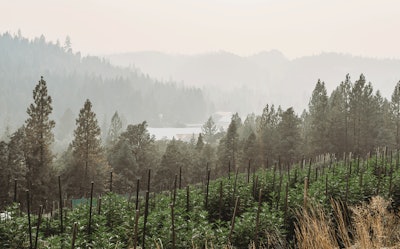
“All I could do is learn as much as I could as quickly as possible, but I had to also have the answers to crop production,” Fortner says. “I had no choice but to apply my horticulture knowledge to producing cannabis. I found out, along with the team, that it does work.
“There are many more similarities than differences between hort and cannabis and, truthfully, cannabis is just another form of horticulture,” Fortner adds.
Fortner has set lofty goals for his new company. “We’re looking to increase production by nearly 400% percent this year,” he says, “all while improving [quality] results at the same time.”
In order to do that, Fortner is looking to pass on his scaling knowledge to the Grown Rogue staff. He emphasizes the importance of the company teaching the next generation of leaders, as well.
“I explain to them that the only way I will promote anyone is if they have their replacement trained and ready to fill their shoes,” Fortner says. “The company is going to continue to grow and need new talent constantly. It’s best if we can tap into people that we know and trust and that know our approach to commercial production.”
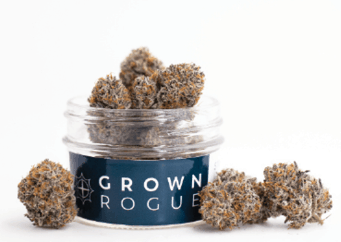
One way in which Fortner has influenced Grown Rogue’s production is by implementing peat-lite mix in crop cultivation. The company previously used soil and coco in the past, and is now trialing coco cubes and different fertilizers, according to Obie, with the goal of reducing labor and driving efficiencies.
The company also utilizes an injection-based system to deliver nutrients to the crop, which Obie says is “just a more efficient way to irrigate the plants.”
Another key aspect of any cultivation is the lighting. While Grown Rogue uses high-intensity discharge (HID) lights “for the most part,” Obie says, the company is currently building its first light-emitting diode (LED) flower room in Michigan.
“We have a lot of LED in our veg space, but [this] will be [our] first flower room dedicated to LED,” Obie says.
While Grown Rogue has never trialed LED lights, he’s optimistic about the downstream benefits.
“We think the technology is finally there to support the right flower development,” Obie says of LED lighting. “Long term, as we look at efficiencies, it’s more cost-effective from a power consumption standpoint, so we think now’s the time to start testing [LEDs], especially as we look at additional expansion in Michigan and new states we might want to turn on.”
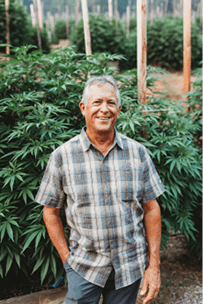
Methodical Expansion
As new opportunities emerge in state markets, Obie says Grown Rogue has eyes on expansion, but he first wants to continue the company’s methodical approach to growth in both Oregon and Michigan.
“Our focus right now is expanding in our core markets in Michigan and Oregon,” he says. “Our goal is to continue to grab market share in each of those states and move ourselves into a top-five product brand in each of those markets. We’ll continue to add production in both of those states over the next several years, not overgrowing our ability to sell, but getting the maximum share we can obtain to create economies of scale.”
Beyond the short-term in Oregon and Michigan, Obie says Grown Rogue would like to eventually add one or two core hubs across the country.
“We’re very excited about states like Arizona and Nevada, [and] even California, where the price point is just higher, [which] creates a lot better profitability,” Obie says. “We’re not aggressively pursuing expansion of new markets because we know how challenging it is to move your business and execute like we did in Michigan, but the economics in those states are very appealing.”
In the interim, Grown Rogue will continue to optimize efficiencies in Oregon and Michigan while also anticipating the prospect of federal legalization.
“Once [federal legalization] happens, and we do believe it’s going to happen one day, we feel like we’re positioned here in southern Oregon as being a fantastic place to grow cannabis,” Sarah says. “We come from a historical position of agriculture here, and we see cannabis as the next evolution for a great product and then being able to share it with the rest of the United States, and the world.”
Zach Mentz is senior editor for Cannabis Business Times.









